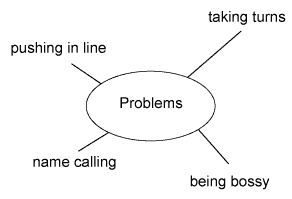Time: approximately 30 minutes (can be done in two sessions of 15 minutes each)
Grouping: whole class and partners
OPENING THE CONVERSATION
- Open the conversation about solving problems by connecting to students’ personal experiences, specifically, the types of problems and conflicts they have encountered and how they have been resolved.
CONNECTING WITH PERSONAL EXPERIENCES
-
I’m going to show you a situation that I saw happen the other day. The two children have a problem… What is their problem?
Introduce the unit by dramatizing a problem situation. Use two child puppets (e.g., boy and girl) to dramatize the following situation: boy and girl are pulling at the same toy. Girl pushes the toy at the boy and the boy falls down and cries. Have students discuss what they think the problem is in the above scenario.
- Ask students to tell about situations where they have had social problems at home or at school. [Making connections]
-
Think about the question: What problems have you had with other people at school or at home? Pair with your partner to discuss your ideas. Be ready to share with the whole group.
Invite students to find a partner sitting in close proximity. Review the format for a Think-Pair-Share activity. You may wish to create a Think-Pair-Share anchor chart for your class using text and drawings (e.g., Think silently; Find a partner; One partner shares; The other partner shares; Share with the group).
- Hold a group discussion about the types of problems students have encountered and record their ideas on a web organizer (created on chart paper or an interactive whiteboard).

- Continue the conversation by giving the following prompts:
- Have you ever had an argument? What did you argue about?
- What is one reason why problems happen?
- Do problems always involve two people or can you have a problem by yourself?
- What kinds of problems happen to one person?
-
How does the little girl feel in this situation? Why do you think that? How does the little boy feel in this situation? Why do you think that? Have you ever felt like the little boy or girl might feel? When?
Re-enact the dramatization with the children struggling over a toy. Have students discuss how the characters would be feeling. [Inferring/evaluating]
INTRODUCING THE INQUIRY QUESTION
-
Together we will learn ways to deal with problems that will be helpful in our classroom, on the playground, and at home.
Tell students that the class will be exploring an interesting question: How can we solve problems? Explain that it is an important question to investigate because everyone finds themselves in difficult situations at some time.
- Record the inquiry question in the middle section of a web organizer (created on chart paper or an interactive whiteboard) and explain that as ideas are discussed, they can be added to the web.
- Review your dramatization of the children struggling with the toy. Have students explain how the children ‘solved’ the problem of sharing the toy and what happened as a result of this solution (pushing, throwing the toy, crying). [Analyzing]
-
What is another way to fix this problem? What could the children have done or said so that no one was hurt or upset?
Invite students to think of alternative ways to solve the problem in a more positive manner. Add these ideas to the web organizer.
-
Those are all good ideas about how the children could have solved their problem. In the next few days, we’re going to read stories that will give us other ideas about how we can solve different problems. We’ll see that there is not necessarily only one way to solve a problem.
Inform students that as they explore the inquiry question they are going to do lots of thinking about problems and how there is not only one way to solve a given problem.
